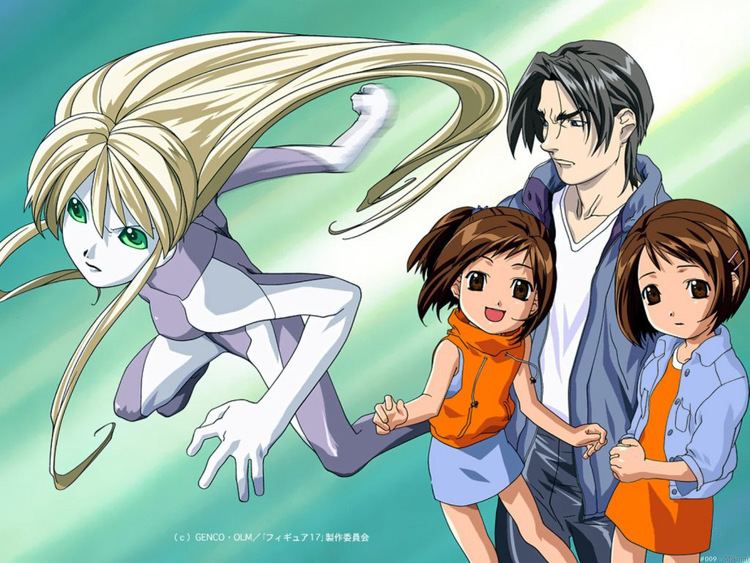7.4 /10 1 Votes7.4
8/10 IMDb Directed by Naohito Takahashi Music by Toshihiko Takamizawa First episode date 27 May 2001 Number of episodes 13 | 7.3/10 MyAnimeList 6.8/10 AniDB Written by Shoji Yonemura Studio GENCO/OLM, Inc. Final episode date 26 May 2002 Program creator Genco and OLM, Inc | |||||||||||||||||||||||||||||||||
 | ||||||||||||||||||||||||||||||||||
Produced by Nobuhiro Osawa, Shukichi Kanda Cast Similar Piano, Full‑Blast Science Adventur, Ray the Animation, Super Robot Wars Orig, Steel Angel Kurumi | ||||||||||||||||||||||||||||||||||
Figure 17 ost battle of fire female chorus version
Figure 17 Tsubasa & Hikaru (フィギュア17つばさ&ヒカル) is an original anime series created by Genco and OLM, Inc. and directed by Naohito Takahashi. The series featured character designs by Yuriko Chiba and music by Toshihiko Takamizawa (of the rock band The Alfee). The series is unusual due to it having an hour time slot per episode (46 minutes of actual episode) rather than the standard half hour time slot.
Contents
- Figure 17 ost battle of fire female chorus version
- Figure 17 all the things she said
- Plot
- Anime
- Manga
- Novel
- Soundtrack
- References

Figure 17 all the things she said
Plot

The anime covers a small portion of the life of the timid, shy, Tsubasa Shiina, a grade schooler who is forced to move to Hokkaidō from Tokyo with her father as he pursues his dream of becoming a baker in the aftermath of her mother's death. At her new school, she is so shy and unsociable that her classmates ignore her at best, and abuse her inability to defend herself at worst.

Shortly after the two begin to settle in, an alien spaceship comes crashing down to earth in the forest behind her house. Stumbling across the ship with her dog, Tsubasa discovers the pilot, unconscious and wounded, and a monster who is trying to kill him. When the monster attacks, the alien wakes and tries to fight off the monster. Tsubasa, in her fright, runs for the ship to hide from the monster. The monster quickly takes care of the alien, seemingly killing him and in the process releasing him from some sort of transformation, and then tries to reach into the ship to get at Tsubasa.

In its effort to reach her, the monster accidentally cracks a mysterious container, the contents of which leak out onto the floor next to Tsubasa. Moments later, the liquid converges upon her and transforms her into what appears to be a young teenage equivalent of the form the man had possessed while fighting the monster. With the aid of this mysterious 'power-up', Tsubasa is able to defeat the monster, though doing so is somewhat accidental on her part.

When the battle is over, instead of simply reverting to her usual form, Tsubasa finds that the strange substance has turned into a near-perfect copy of herself on separation. This new girl introduces herself, claiming the name Hikaru. The alien awakens, but does not transform into the appearance he had on Tsubasa's arrival at his ship. Together, all three return to Tsubasa's house and stay the night in her room.

The next day the man introduces himself as D.D. -an alien- and explains that he was transporting the seeds of a monster called a Maguar, when suddenly one of the seeds hatched and attacked him, forcing him into a crash landing on Earth. Unfortunately, the Maguar that Tsubasa defeated was only 1 of 6 that he had been transporting, and D.D. explains that the other 5 have escaped the ship and are each scattered somewhere throughout Hokkaidō.
He tells the girls that he needs them to help him destroy the remaining 5 Maguar since the atmosphere of the earth has enhanced both Hikaru- who is a form of combat suit known as a Figure- and the Maguar in a similar way, while he waits for reinforcements.
To facilitate the problem of suddenly having a twin that no one knows about, D.D. decides to modify the memories of Tsubasa's father, making him believe that he had twin daughters all along, and that Hikaru was simply living elsewhere with an aunt. D.D. proceeds to monitor the Maguar from his ship, while Tsubasa and Hikaru live together at Tsubasa's house, go to school together at Tsubasa's school, fight together as Figure 17 against the Maguar, and essentially become siblings in a more emotional sense.
Each episode consists of about 35–40 minutes of Tsubasa's & Hikaru's school life, and is typically concluded by about 5–10 minutes of Maguar fighting. The main point of this series is more about Tsubasa growing up and learning how to cope with life events- such as the loss of her mother and her familiar environment- than the alien-monster fighting which is present throughout each episode. The plot is driven as much by Tsubasa learning from Hikaru and her experiences with her new sister at school as it is by the presence of the Maguar, and there tends to be less cross-interference of mundane and fantastic life than is typical of 'magical girl' type anime.
Anime
Bandai Visual distributed the series on DVD in Japan in single-episode volumes, totaling 13 volumes. It was licensed in North America by Media Blasters (under the AnimeWorks label) and released in six DVD volumes from 2003 to 2004, as well as a boxed set in 2005. This version was also licensed in Australia and New Zealand by Madman Entertainment.
Manga
A manga adaptation of the series was illustrated by Guy Nakahira and published in the magazine Dengeki Daioh. Spanning only two volumes, the adaptation is considerably shorter than the TV series, condensing most of the series' storyline, removing some of the supporting characters and shortening the fight scenes to only a few pages. The manga was licensed in North America and translated in English by ADV Manga.
Novel
A novelization of the series was penned by screenplay writer Shoji Yonemura with illustrations by character designer Yuriko Chiba and published by Dengeki Bunko.
Soundtrack
The series' soundtrack, released by Lantis, consists of the background music. The opening and ending themes are not available on this disc. In addition, an image album was released, featuring songs performed by Akiko Yajima and Fumiko Orikasa.
